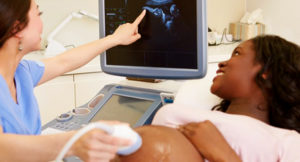My Third Trimester
Week 36
Estimated Reading Time: 3 minutes
At the end of your 36th week, your baby’s skin is now becoming free of wrinkles with no slack. A tiny face is now perfectly circular as little muscles have matured, and sucking will soon be required in providing nourishment upon delivery. Your baby’s skull is supple and pliable and will remain so until delivery. Your baby’s other bones continue to solidify.
Continue to Track Your Baby’s Daily Movements Until Your Baby is Born. Your baby’s movements & heart rate will basically stay the same now. Movements may or may not become less defined as specific punches and kicks, they can feel more like twirls, twists and jiggles. If you notice any changes in your baby’s movement patterns, such as a decrease, increase, or absence in fetal movement, CALL your health care team immediately to make sure baby is well. If you are unable to reach or visit your health care team, go to Labor & Delivery or the Emergency Room. Do not wait until the next day or next appointment! Always trust your instincts.
Your baby is now tipping the scales at around 6 pounds.
Your Baby’s 36-Week Ultrasound
 Request an additional ultrasound now to examine the umbilical cord and placenta for normal development and position. Ask that EPV be measured at this and every ultrasound (visit Week 7 to learn the importance of keeping up-to-date with placental measurements.)
Request an additional ultrasound now to examine the umbilical cord and placenta for normal development and position. Ask that EPV be measured at this and every ultrasound (visit Week 7 to learn the importance of keeping up-to-date with placental measurements.)
Dr. Collins believes an ultrasound at this time could detect a potential problem, making it a useful proactive pregnancy tool. The umbilical cord is a definite risk factor during the later part of your pregnancy and could compromise your baby. As mentioned in Week 28, UCAs, including nuchal cords, true knots, twists, torsion, kinks and long or short cords, account for 16 percent of the 26,000 yearly deaths in utero in the USA. That is at least 71 untimely deaths each and every day in our country. Dr. Collins states a UCA is not a “rare condition or event” and should be watched for especially in the last trimester of pregnancy. He advocates an ultrasound be done if decreased fetal movements are noted for a day.
If your healthcare team is concerned about any aspect of your pregnancy and performs an ultrasound at any other time during your pregnancy, please ask the team to repeat the EPV measurement again at that time.
After your ultrasound
If a problem is seen on your baby’s ultrasound with the umbilical cord or placenta, a plan of action needs to be decided upon with your health care team. Examples of close monitoring include repeat office visits, ultrasounds, Fetal Non-Stress Tests (NST), Biophysical Profiles (BPP), Cord (blood flow) Doppler tests, very diligent movement counting and daily home fetal heart rate monitoring.
If you and your health care team determine your baby should have further monitoring following your 36-week ultrasound, or you are considered high risk, don’t panic! Remember, it is comforting and reassuring to know your baby is healthy and stable thanks to the frequent monitoring. The four main reasons for monitoring your baby are to ensure that your baby is comfortable in utero, to ensure that your baby’s heart rate is normal and steady with no significant decelerations (decels) present, the placenta is working efficiently and not appearing to be aged, and to ensure that there are no signs of preterm or premature labor present. And continue movement counting three times a day until your baby arrives.